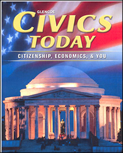Civics Today Citizenship, Economics, & YouChapter 17:
Citizenship and the InternetWeb Activity Lesson PlansIntroduction
The Internet is a mass communication system of millions of networked computers and databases all over the world. Governments, banks and industries, students, senior citizens, and many others use it. How has this vast network of computers spread? Is anyone in charge of it? In this activity students will learn about the growth of the Internet.
Lesson Description
In this lesson students will visit Nerds 2.0.1, a online feature hosted by PBS on the history of the Internet. After reading through a time line and browsing through the Glossary of Geek, students will answer several questions. Finally they will write an essay predicting how computer technology will be different in another 20 years.
Instructional Objectives- The learner will be able to identify milestones in the development of the Internet.
- The learner will be able to identify people who have helped increase the use of the Internet.
- The learner will be able to formulate predictions about the future of computer technology.
Student Web Activity Answers- ARPANet was the forerunner to the Internet. It began as a government program, and initially had only four computers connected to it.
- Apple and IBM were most responsible for the growth of personal computers.
- Tim Berners-Lee, a computer programmer at CERN in Switzerland, came up with the name "World Wide Web."
- A problem some experts predict for the Internet is that it will become so crowded, people will stop using it.
- Students' essays will vary.
 | 




